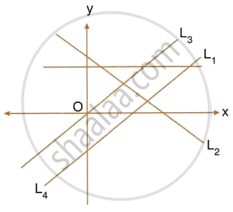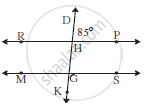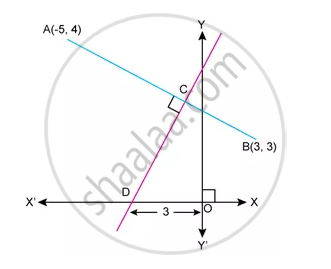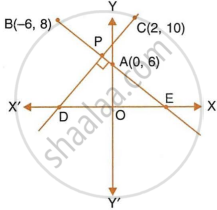Advertisements
Advertisements
प्रश्न
A (5, 4), B (–3,–2) and C (1,–8) are the vertices of a triangle ABC. Find the equation of median AD and line parallel to AB passing through point C.
उत्तर
It is given that A(5, 4), B(–3, –2) and C(1, –8) are the vertices of a triangle ABC.
Let the coordinates of point D be (a, b).
Also, D is the mid-point of side BC
So,
\[a = \frac{- 3 + 1}{2}, b = \frac{- 2 + \left( - 8 \right)}{2}\]
\[ \Rightarrow a = \frac{- 2}{2}, b = \frac{- 10}{2}\]
\[ \Rightarrow a = - 1, b = - 5\]
Thus, the coordinates of point D are (−1, −5).
The equation of median AD is
\[y - y_1 = \left( \frac{y_2 - y_1}{x_2 - x_1} \right)\left( x - x_1 \right)\]
\[ \Rightarrow y - 4 = \left( \frac{- 5 - 4}{- 1 - 5} \right)\left( x - 5 \right)\]
\[ \Rightarrow y - 4 = \left( \frac{- 9}{- 6} \right)\left( x - 5 \right)\]
\[ \Rightarrow y - 4 = \frac{3}{2}\left( x - 5 \right)\]
\[ \Rightarrow 2y = 3x - 7\]
A line parallel to AB will have the same slope as AB.
Slope of AB = \[\frac{y_2 - y_1}{x_2 - x_1} = \frac{- 2 - 4}{- 3 - 5} = \frac{- 6}{- 8} = \frac{3}{4}\]
So, the equation of line parallel to AB and passing through the point C(1, –8) is
\[y - y_1 = m\left( x - x_1 \right)\]
\[ \Rightarrow y - \left( - 8 \right) = \frac{3}{4}\left( x - 1 \right)\]
\[ \Rightarrow 3x - 4y - 35 = 0\]
APPEARS IN
संबंधित प्रश्न
Write the equation of the line passing through the pair of points (2, 3) and (4, 7) in the form of y = mx + c.
A (5, 4), B (-3, -2) and C (1, -8) are the vertices of a triangle ABC. Find the equations of the median AD and line parallel to AC passing through the point B.
If (4,-3) is a point on the line AB and slope of the line is (-2), write the equation of the line AB.
Find the slope and y-intercept of the line:
ax – by = 0
Is the line 3x + 2y = 5 parallel to the line x + 2y = 1?
Find the equation of the line passing through (−2, 1) and perpendicular to 4x + 5y = 6.
B(−5, 6) and D(1, 4) are the vertices of rhombus ABCD. Find the equations of diagonals BD and AC.
- Write down the equation of the line AB, through (3, 2) and perpendicular to the line 2y = 3x + 5.
- AB meets the x-axis at A and the y-axis at B. Write down the co-ordinates of A and B. Calculate the area of triangle OAB, where O is the origin.
The line 4x − 3y + 12 = 0 meets x-axis at A. Write the co-ordinates of A. Determine the equation of the line through A and perpendicular to 4x – 3y + 12 = 0.
Match the equations A, B, C and D with the lines L1, L2, L3 and L4, whose graphs are roughly drawn in the given diagram.
A ≡ y = 2x;
B ≡ y – 2x + 2 = 0;
C ≡ 3x + 2y = 6;
D ≡ y = 2

Find the point on the X–axis which is equidistant from A(–3, 4) and B(1, –4).

In the adjoining figure line RP ||line MS , line DK is a transversal . If ∠DHP = 85° find ∠RHG and ∠HGS.
Prove that :
“If a line parallel to a side of a triangle intersects the remaining sides in two distince points, then the line divides the sides in the same proportion.”
Find Equation of CD

In the given figure, line AB meets y-axis at point A. Line through C(2, 10) and D intersects line AB at right angle at point P. Find:

- equation of line AB.
- equation of line CD.
- co-ordinates of points E and D.
Find the equation of the line passing through the points (4,-5) and (-1,-2).
A line is parallel to Y-axis and is at a distance of 5 units from the Y-axis. Write the equation of that line.
